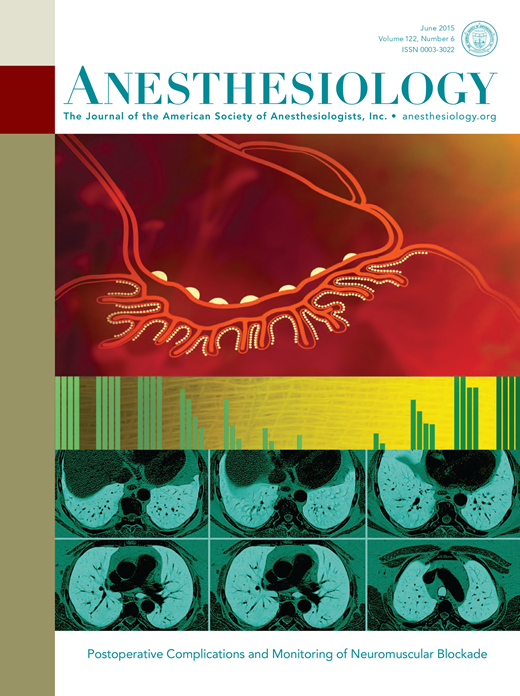Effects of sedative doses of propofol, dexmedetomidine, and fentanyl on memory and pain in healthy young adults: A randomized controlled single-blind crossover study using functional magnetic resonance imaging at 7 Tesla.
IF 9.1
1区 医学
Q1 ANESTHESIOLOGY
引用次数: 0
Abstract
BACKGROUND Anesthetic agents are well known for their effects on memory and pain, however, prior studies quantifying anesthetic-modulation of memory have not included experimental noxious stimulation. This study used functional magnetic resonance imaging (fMRI) to determine how low doses of propofol, dexmedetomidine, and fentanyl affect the brain systems for memory encoding and pain perception. METHODS This was a single-blind 1:1:1 randomized placebo-controlled crossover study of 92 healthy volunteers age 18-40. Effect-site concentrations were targeted for propofol (1.0 mcg/ml), dexmedetomidine (0.15 ng/ml), or fentanyl (0.9 ng/ml). Participants listened to a series of 80 words creating a mental picture. Thirty were accompanied by a 2 s painful shock. Blood oxygen-weighted images were obtained at 7 Tesla using a custom head coil. The primary outcome was next-day memory performance, measured by d´, a normalized measure of correct identifications versus false positives. Mixed models were fit to test outcome differences between drug groups. Only statistically significant (p < 0.05) changes are reported, after adjustment for multiple comparisons. RESULTS Recollection, reported as mean d´ (95% confidence interval), was 1.16 (0.97-1.34) under No Drug. This was reduced under propofol 0.51 (0.182-0.842), P=0.006, but not dexmedetomidine 1.04 (0.73-1.35), P=0.99, or fentanyl 0.98 (0.68-1.28), P=0.99. Propofol decreased memory-encoding activation of the hippocampus and amygdala. Propofol reduced pain-related activation in the insula, anterior cingulate, hippocampus, and amygdala. Dexmedetomidine showed decreased memory-related activation in the hippocampus, but did not change pain ratings nor show activation differences in pain-processing areas. Fentanyl showed decreased memory activation in the hippocampus and amygdala. During painful stimulation, fentanyl decreased activation in the primary somatosensory cortex, insula, and increased activation in the anterior cingulate, hippocampus, and amygdala. CONCLUSIONS These findings add important details to the complex framework of how these distinct anesthetics affect different aspects of cognition through diverse neuroanatomical targets in the brain.镇静剂量异丙酚、右美托咪定和芬太尼对健康年轻人记忆和疼痛的影响:一项使用7特斯拉功能磁共振成像的随机对照单盲交叉研究
背景:麻醉药因其对记忆和疼痛的影响而闻名,然而,先前的研究量化了麻醉对记忆的调节,并没有包括实验性的有害刺激。本研究使用功能性磁共振成像(fMRI)来确定低剂量异丙酚、右美托咪定和芬太尼如何影响大脑系统的记忆编码和疼痛感知。方法采用单盲1:1:1随机安慰剂对照交叉研究,纳入92名年龄在18-40岁的健康志愿者。效应位点浓度分别为异丙酚(1.0 mcg/ml)、右美托咪定(0.15 ng/ml)或芬太尼(0.9 ng/ml)。参与者听了一系列80个单词,在脑海中形成一幅画面。其中30例伴有2秒的痛苦休克。使用定制的头部线圈在7特斯拉时获得血氧加权图像。主要结果是第二天的记忆表现,用d´来衡量,d´是正确识别与误报的标准化衡量标准。采用混合模型检验不同药物组间的结果差异。经多次比较调整后,仅报告有统计学意义(p < 0.05)的变化。结果无药组的回忆为1.16(0.97-1.34),以平均d´(95%置信区间)表示。异丙酚组降低了0.51 (0.182-0.842),P=0.006,右美托咪定组降低了1.04 (0.73-1.35),P=0.99,芬太尼组降低了0.98 (0.68-1.28),P=0.99。异丙酚降低了海马体和杏仁核的记忆编码激活。异丙酚减少了脑岛、前扣带、海马体和杏仁核中与疼痛相关的激活。右美托咪定显示海马记忆相关的激活减少,但没有改变疼痛等级,也没有显示疼痛处理区域的激活差异。芬太尼显示海马和杏仁核的记忆激活降低。在疼痛刺激过程中,芬太尼降低初级体感觉皮层、脑岛的激活,增加前扣带、海马体和杏仁核的激活。这些发现为这些不同的麻醉药如何通过大脑中不同的神经解剖靶点影响认知的不同方面的复杂框架提供了重要的细节。
本文章由计算机程序翻译,如有差异,请以英文原文为准。
求助全文
约1分钟内获得全文
求助全文
来源期刊

Anesthesiology
医学-麻醉学
CiteScore
10.40
自引率
5.70%
发文量
542
审稿时长
3-6 weeks
期刊介绍:
With its establishment in 1940, Anesthesiology has emerged as a prominent leader in the field of anesthesiology, encompassing perioperative, critical care, and pain medicine. As the esteemed journal of the American Society of Anesthesiologists, Anesthesiology operates independently with full editorial freedom. Its distinguished Editorial Board, comprising renowned professionals from across the globe, drives the advancement of the specialty by presenting innovative research through immediate open access to select articles and granting free access to all published articles after a six-month period. Furthermore, Anesthesiology actively promotes groundbreaking studies through an influential press release program. The journal's unwavering commitment lies in the dissemination of exemplary work that enhances clinical practice and revolutionizes the practice of medicine within our discipline.
 求助内容:
求助内容: 应助结果提醒方式:
应助结果提醒方式:


